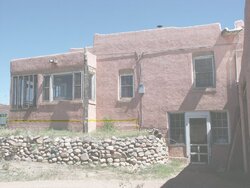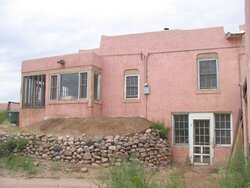Context:
78 YO house, 2 ft thick uninsulated masonry walls, full daylight basement with walkin on north side (bummer), massive concrete foundation with basement stairs, laundry room floor, and two porches all poured along with the foundation. The front of the house faces south, but the south side is bermed and the north side is exposed, exactly backwards from what we want. They don't build 'em like this any more... for good reason.
One of the worst thermal weak spots is the massive concrete pouring on the north side which forms the basement stairs, laundry room floor, adjoining porch, and north side basement wall. 4 or 5 feet high by 20+ feet of this mass is directly exposed to the outside, and in the winter, it is a huge thermal sink. It's the coldest part of the house by far.
The correct thing to do would be to foam insulate the exterior of the whole north side and get that whole mass inside the heated envelope. But it may be a few years before we can budget that in - first priority is some passive solar treatment on the south side. So until then, I'm looking for an inexpensive way to insulate this mass from direct exposure to the cold air.
That's where the straw bales come in. Very cost-effective insulation. But it has to be kept dry. I'm envisioning the bales in some sort of bag or covering (say, polypropylene or similar) that will hold up for a few years. Stack them up to cover this mass. Looks aren't important - this is the back of the house and it can't be seen from any adjacent properties.
Anyone ever seen anything like this? Is this idea crazy? Your thoughts are welcome and appreciated.
78 YO house, 2 ft thick uninsulated masonry walls, full daylight basement with walkin on north side (bummer), massive concrete foundation with basement stairs, laundry room floor, and two porches all poured along with the foundation. The front of the house faces south, but the south side is bermed and the north side is exposed, exactly backwards from what we want. They don't build 'em like this any more... for good reason.
One of the worst thermal weak spots is the massive concrete pouring on the north side which forms the basement stairs, laundry room floor, adjoining porch, and north side basement wall. 4 or 5 feet high by 20+ feet of this mass is directly exposed to the outside, and in the winter, it is a huge thermal sink. It's the coldest part of the house by far.
The correct thing to do would be to foam insulate the exterior of the whole north side and get that whole mass inside the heated envelope. But it may be a few years before we can budget that in - first priority is some passive solar treatment on the south side. So until then, I'm looking for an inexpensive way to insulate this mass from direct exposure to the cold air.
That's where the straw bales come in. Very cost-effective insulation. But it has to be kept dry. I'm envisioning the bales in some sort of bag or covering (say, polypropylene or similar) that will hold up for a few years. Stack them up to cover this mass. Looks aren't important - this is the back of the house and it can't be seen from any adjacent properties.
Anyone ever seen anything like this? Is this idea crazy? Your thoughts are welcome and appreciated.


 She's an amazing hunter.
She's an amazing hunter.


